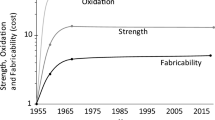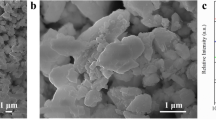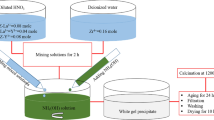Abstract
Polynitrogen compounds (containing only nitrogen atoms) are promising candidates as energetic materials for rocket engineering. The high energy content of these compounds is due to the significant difference in bond energy between nitrogen atoms. In particular, molecular nitrogen (N2) is characterized by a uniquely strong triple bond — 229 kcal/mole, whereas the single-bond energy is only 38.4 kcal/mole. From theoretical estimates, use of polynitrogen compounds can provide a specific impulse of 350–500 sec with material density in a range of 2.0–3.9 g/cm3. This paper gives a brief review of the current status of experimental and theoretical studies in the chemistry of polynitrogen compounds.
Similar content being viewed by others
References
High Energy Density Materials, Springer, Berlin-Heidelberg (2007) (Structure and Bonding Ser., Vol. 125).
M. B. Talawar, R. Sivabalan, S. N. Aasthana, and H. Singh, “Novel ultrahigh energy materials,” Combust., Expl., Shock Waves, 41, No. 3, 264–277 (2005).
P. C. Samartzis and A. M. Wodtke, “All-nitrogen chemistry: how far are we from N60?,” Int. Rev. in Phys. Chem., 25, No. 4, 527–552 (2006).
D. B. Lempert, G. N. Nechiporenko, and S. I. Soglasnova, “Energetic potential of compositions based on high-enthalpy polynitrogen compounds,” Combust., Expl., Shock Waves, 45, No. 2, 160–168 (2009).
Discovery of New Polynitrogen May Open Door to a New Class of Chemical Propellants, Dec 01-AFRL Horizons, http://www.hobbyspace.com/Links/LaunchPropulsion.html#Propellants.
B.M. Rice, E. F. C. Byrd, and W. D. Mattson, “Computational aspects of nitrogen-rich HEDMs,” High Energy Density Materials, Springer, Berlin-Heidelberg (2007), pp. 153–194 (Structure and Bonding Ser., Vol. 125).
D. Rutherford, De aero fixo ant mephitic (On air said to be fixed or mephitic): MD thesis, University of Edinburgh, 1772.
T. Curtius, “The azide ion,” Berichte Dtsch. Chem. Ges., 23, 3023 (1890).
T. A. Scott, “Solid and liquid nitrogen,” Phys. Rep., 27, No. 3, 89–157 (1976).
B. A. Thrush, “The detection of free radicals in the high intensity photolysis of hydrogen azide,” Proc. Roy. Soc. London, Ser. A: Math. Phys. Sci., 235, 143–147 (1956).
J. M. L. Martin, J. P. Francois, and R. Gijbels, “Ab initio study of boron, nitrogen, and boron-nitrogen clusters. I. Isomers and thermochemistry of B3, B2N, BN2, and N3,” J. Chem. Phys., 90, No. 11, 6469–6485 (1989).
J. Wasilewski, “Stationary points on the lowest doublet and quartet hypersurfaces of the N3 radical: A comparison of molecular orbital and density functional approaches,” J. Chem. Phys., 105, No. 24, 10969–10982 (1996).
M. J. Pellerite, R. L. Jackson, and J. I. Brauman, “Proton affinity of the gaseous azide ion. The N H bond dissociation energy in HN3,” J. Phys. Chem., 85, 1624–1626 (1981).
J. M. L. Martin, J. P. Francois, and R. Gijbels, “The dissociation energy of N3,” J. Chem. Phys., 93, No. 6, 4485–4486 (1990).
P. Zhang, K. Morokuma, and A. M. Wodtke, “High-level ab initio studies of unimolecular dissociation of the ground-state N3 radical,” J. Chem. Phys., 122, 014106 (2005).
Y. G. Byun, S. Saebo, C. U. Pittman, and J. Amer, “An ab initio study of potentially aromatic and antiaromatic three-membered rings,” Chem. Soc., 113, 3689–3696 (1991).
R. Tarroni and P. Tosi, “Cyclic and bent electronic states of the N +3 ion,” Chem. Phys. Lett., 389, 274–278 (2004).
Z. L. Cai, Y. F. Wang, and H. M. Xiao, “Ab initio study of low-lying electronic states of the N +3 ion,” Chem. Phys., 164, 377–381 (1992).
F. Carnovale, J. B. Peel, and R. G. Rothwell, “Photoelectron spectroscopy of the nitrogen dimer (N2)2 and clusters (N2)n:N2 dimer revealed as the chromophore in photoionization of condensed nitrogen,” J. Chem. Phys., 88, No. 2, 642–650 (1988).
V. Aquilanti, M. Bartolomei, D. Cappelletti, E. Carmona-Novillo, and F. Pirani, “Dimers of the major components of the atmosphere: Realistic potential energy surfaces and quantum mechanical prediction of spectral features,” Phys. Chem. Chem. Phys., 3, 3891–3894 (2001).
F. M. Bickelhaupt, R. Hoffmann, and R. Levine, “Forbidden four-center reactions: Molecular orbital considerations for N2 + N2 and N2 + N2+,” J. Phys. Chem. A, 101, 8255–8263 (1997).
C. Leonard, P. Rosmus, S. Carter, and N. C. Handy, “Potential energy function and vibrational states of the electronic ground state of N +4 ,” J. Phys. Chem. A, 103, 1846–1852 (1999).
L. G. McKnight, K. B. McAfee, and D. P. Sipler, “Lowfield drift velocities and reactions of nitrogen ions in nitrogen,” Phys. Rev., 164, 62–70 (1967).
M. M. Francl and J. P. Chesick, “The N4 molecule and its metastability,” J. Phys. Chem., 94, 526–528 (1990).
M. Bittererova, T. Brinck, and H. Ostmark, “Theoretical study of the triplet N4 potential energy surface,” J. Phys. Chem. A, 104, No. 51, 11999–12005 (2000).
S. Evangelisti, “Properties, dynamics, and electronic structure of atoms and molecules,” Int. J. Quantum Chem., 96, No. 6, 598–606 (2004).
P. Pyykko and N. Runeberg, “Ab initio studies of bonding trends: Part 9. The dicyanamide-carbon suboxide-dicyanoethercyanogen azide isoelectronic series A=B=C=D=E1,” J. Mol. Struct. Theochem., 234, 279–290 (1991).
K. O. Christe, W. W. Wilson, J. A. Sheehy, and J. A. Boatz, “N +5 : a novel homoleptic polynitrogen ion as a high energy density material,” Angew. Chemie, Int. Ed., 38, Nos. 13/14, 2004–2009 (1999).
M. T. Nguyen and T. K. Ha, “Theoretical study of the pentanitrogen (N +5 ),” Chem. Phys. Lett., 317, 135–141 (2000).
D. A. Dixon, D. Feller, K. O. Christe, et al. “Enthalpies of formation of gas-phase N3, N −3 , N −5 , and N −5 from ab initio molecular orbital theory, stability predictions for N +5 N −3 and N +5 N −5 , and experimental evidence for the instability of N +5 N −3 ,” J. Amer. Chem. Soc., 126, No. 3, 834–843 (2004).
X. Wang, H. R. Hu, A. M. Tian, N. B. Wong, S. H. Chien, and W. K. Li, “An isometric study of N +5 , N5, and N −5 : a Gaussian-3 investigation,” Chem. Phys. Lett., 329, 483–489 (2000).
M. T. Nguyen, M. A. McGinn, A. F. Hegarty, and J. Elguero, “Can the pentazole anion (N −5 ) be isolated and/or trapped in metal complexes?,” Polyhedron, 4, No. 10, 1721–1726 (1985).
Q. S. Li and Y. D. Liu, “Theoretical studies of the N6 potential energy surface,” J. Phys. Chem. A, 106, 9538–9542 (2002).
R. Engelke and J. R. Stine, “Is N8 cubane stable?,” J. Phys. Chem., 94, 5689–5694 (1990).
M. L. Leininger, C. D. Sherrill, and H. F. Schaefer, “N8: Structure analogous to pentalene, and other high energy density minima,” J. Phys. Chem., 99, 2324–2328 (1995).
L. Gagliardi, S. Evangelisti, A. Bernhardsson, R. Lindh, and B. O. Roos, “Dissociation reaction of N8 azapentalene to 4N2: A theoretical study,” Int. J. Quant. Chem., 77, 311–315 (2000).
M. N. Glukhovtsev, H. J. Jiao, and P. V. Schleyer, “Besides N2, what is the most stable molecule composed only of nitrogen atoms?,” Inorg. Chem., 35, No. 24, 7124–7133 (1996).
S. Li, H. Qu, and Q. S. Li, “Quantum chemical study on N60,” Chem. J. Chinese Univ., 18, 297 (1997).
M. R. Manaa, “Toward new energy-rich molecular systems: from N10 to N60,” Chem. Phys. Lett., 331, Nos. 2–4, 262–268 (2000).
L. J. Wang and Z. M. Zgierski, “Super-high energy-rich nitrogen cluster N60,” Chem. Phys. Lett., 376, No. 5–6, DOI 698703 (2003).
H. Zhoua, N.-B. Wongb, and A. Tiana, “Theoretical study on the cylinder-shaped N78 cage,” J. Mol. Graphics Modell., 25, No. 4, 578–583 (2006).
H. Zhoua and N.-B. Wongb, “Theoretical investigation on the cylinder-shaped N84 cage,” Chem. Phys. Lett., 449, Nos. 4–6, 272–275, (2007).
S. P. Lewis and M. L. Cohen, “High-pressure atomic phases of solid nitrogen,” Phys. Rev. B, 46, 11117–11120 (1992).
C. Mailhiot, L. H. Yang, and A. K. McMahan, “Polymeric nitrogen,” Phys. Rev. B, 46, No. 22, 14419–14435 (1992).
W. D. Mattson, D. Sanchez-Portal, S. Chiesa, and R. M. Martin, “Prediction of new phases of nitrogen at high pressure from first-principles simulations,” Phys. Rev. Lett., 93, 125501–125505 (2004).
R. Caracas and R. J. Hemley, “New structures of dense nitrogen: pathways to the polymer phase,” Chem. Phys. Lett., 442, Nos. 1–3, 65–70 (2007).
F. Zahariev, S. V. Dudiy, J. Hooper, F. Zhang, and T. K. Woo, “Systematic method to new phases of polymeric nitrogen under high-pressure,” Phys. Rev. Lett., 97, 155503 (2006).
H. Abou-Rachid, A. Hu, D. Arato, et al., “Novel nanoscale high energetic materials: nanostructure polymeric nitrogen and polynitrogen,” in: 7th Int. Symp. on Special Topics in Chem. Prop., Book of Abstracts, Kyoto, Japan (2007), p. 163; See also in: K. K. Kuo and K. Hori (eds.), Advancements in Energetic Materials and Chemical Propulsion, Begell House, New York, (2008), pp. 364–376.
H. Abou-Rachid, A. Hu, V. Timoshevskii, et al., “Nanoscale high energetic materials: A polymeric nitrogen chain N8 confined inside a carbon nanotube,” Phys. Rev. Lett., 100, No. 1–4, 196401 (2008).
A. E. Douglas and W. J. Jones, “The 2700 Å bands of the N3 molecule,” Can. J. Phys., 43, 2216 (2008).
N. Hansen and A. M. Wodtke, “Velocity map ion imaging of chlorine azide photolysis: Evidence for photolytic production of cyclic-N3,” J. Phys. Chem. A, 107, 10608 (2003).
N. Hansen, A. M. Wodtke, S. J. Goncher, J. C. Robinson, N. E. Sveum, and D. M. Neumark, “Photofragment translation spectroscopy of ClN3 at 248 nm: Determination of the primary and secondary dissociation pathways,” J. Chem. Phys., 123, 104305 (2005).
J. Zhang, Y. Chen, K. Yuan, S. A. Harich, X. Wang, X. Yang, P. Zhang, Z. Wang, K. Morokuma, and A. M. Wodtke, “An experimental and theoretical study of ring closing dynamics in HN3,” Phys. Chem. Chem. Phys., 8, 1690–1696 (2006).
C. Larson, Yu. Ji, P. C. Samartzis, et al., “Observation of photochemical C-N bond cleavage in CH3N3: A new photochemical route to cyclic N3,” J. Phys. Chem., 112, No. 6, 1105–1111 (2008).
J. M. Dyke, H. N. B. Jonathan, A. E. Lewis, and A. Morris, “Vacuum ultraviolet photoelectron spectroscopy of transient species. Pt 15. The N3(X 2II) radical,” Mol. Phys., 47, 1231–1240 (1982).
C. L. Haynes, W. Freysinger, and P. B. Armentrout, “Collision-induced dissociation of N +3 (X 3 σ −) with NE, AR, KR, and XE,” Int. J. Mass Spectr., 150, 267–278 (1995).
P. C. Samartzis, J. J. M. Lin, T. T. Ching, et al. “Two photoionization thresholds of N3 produced by ClN3 photodissociation at 248 nm: further evidence for cyclic N3,” J. Chem. Phys., 123, No. 5, 051101 (2005).
M. Whitaker, M. A. Biondi, and R. Johnsen, “Electron-temperature dependence of dissociative recombination of electrons with N +2 · N2 dimer ions,” Phys. Rev. A, 24, 743–745 (1981).
L. B. Knight, K. D. Johannessen, D. C. Cobranchi, E. A. Earl, D. Feller, and E. R. Davidson, “ESR and ab initio theoretical studies of the cation radicals 14N +4 and 15N +4 . The trapping of ion-net at 4 K,” J. Chem. Phys., 87, 885–897 (1987).
J. P. Zheng, J. Waluk, J. Spanget-Larsen, D. M. Blake, and J. G. Radziszewski, “Tetrazete (N4). Can it be prepared and observed?,” Chem. Phys. Lett., 328, 227–233 (2000).
F. Cacase, G. de Petris, and A. Troiani, “Experimental detection of tetranitrogen,” Science, 295, 480–481 (2002).
F. Cacase, “From N2 and O2 to N4 and O4: Pneumatic chemistry in the 21st centry,” Chem. Europ. J., 8, 3839–3847 (2002).
E. E. Renie and P. M. Mayer, “Confirmation of the long-lived tetra-nitrogen (N4) molecule using neutralization-reionization mass spectrometry and ab initio calculations,” J. Chem. Phys., 120, No. 22, 10561–10578 (2004).
P. Zurer, “Chemistry’s top five achievements in 1999,” Chem. Eng. News, 77, No. 4, 7 (1999).
A. Vij, W. W. Wilson, V. Vij, F. S. Tham, J. A. Sheehy, and K. O. Christe, “Polynitrogen chemistry. Synthesis, characterization, and crystal structure of surprisingly stable fluoroantimonate salts of N +5 ,” J. Amer. Chem. Soc., 123, 6308 (2001).
K. O. Christe, “Recent advances in the chemistry of N, N and high-oxygen compounds,” Propellants, Explosives, Pyrotechnics, 32, No. 3, 194–204 (2007).
A. Vij, J. G. Pavlovich, W. W. Wilson, V. Vij, and K. O. Christe, “Experimental detection of the pentaazacyclopentadienide (pentazolate) anion, cyclo-N −5 , Angew. Chemie, Intern. Ed., 41, S. 3051 (2002).
M. I. Eremets, R. J. Eremets, and H.-k. Mao, “Semiconducting non-molecular nitrogen up to 240 GPa and its low-pressure stability,” Nature, 411, 170–174 (2001).
M. I. Eremets, A. G. Gavriliuk, I. A. Trojan, D. A. Dzivenko, and R. Boehler, “Single-bonded cubic form of nitrogen,” Nature Mater., 3, 558–563 (2004).
M. Popov, “Raman and IR study of high-pressure atomic phase of nitrogen,” Phys. Lett. A, 334, 317–325 (2005).
M. I. Eremets, A. G. Gavriliuk, N. R. Serebryanaya, I. A. Trojan, D. A. Dzivenko, R. Boehler, H.-k. Mao, and R. J. Hemley, “Structural transformation of molecular nitrogen to a single-bonded atomic state at high pressures,” J. Chem. Phys., 121, No. 22, 11296–11300 (2004).
M. I. Eremets, A. G. Gavriliuk, and I. A. Trojan, “Single-crystalline polymeric nitrogen,” Appl. Phys. Lett., 90, Nos. 1–3, 171904 (2007).
M. J. Lipp, J. P. Klepeis, B. J. Baer, et al., “Transformation of molecular nitrogen to nonmolecular phases at megabar pressures by direct laser heating,” Phys. Rev. B, 76, 014113 (1–5) (2007).
A. F. Goncharov, J. C. Crowhurst, V. V. Struzhkin, and R. J. Hemley, “Triple point on the melting curve and polymorphism of nitrogen at high pressure,” Phys. Rev. Lett., 101, 095502 (1–4) (2008).
X-Q. Chen, C. L. Fu, and R. Podloucky, “Bonding and strength of solid nitrogen in the cubic gauche (Cg-N) structure,” Phys Rev. B, 77, 064103 (1–6) (2008).
Author information
Authors and Affiliations
Corresponding author
Additional information
__________
Translated from Fizika Goreniya i Vzryva, Vol. 46, No. 2, pp. 3–16, March–April, 2010.
Rights and permissions
About this article
Cite this article
Zarko, V.E. Searching for ways to create energetic materials based on polynitrogen compounds (review). Combust Explos Shock Waves 46, 121–131 (2010). https://doi.org/10.1007/s10573-010-0020-x
Received:
Published:
Issue Date:
DOI: https://doi.org/10.1007/s10573-010-0020-x




